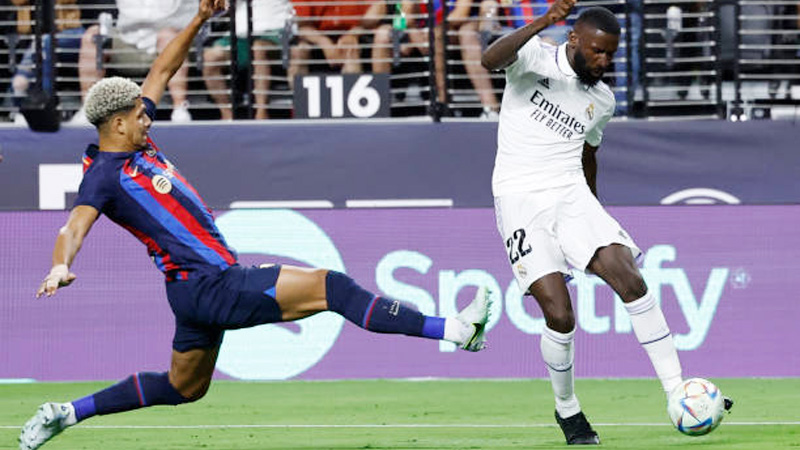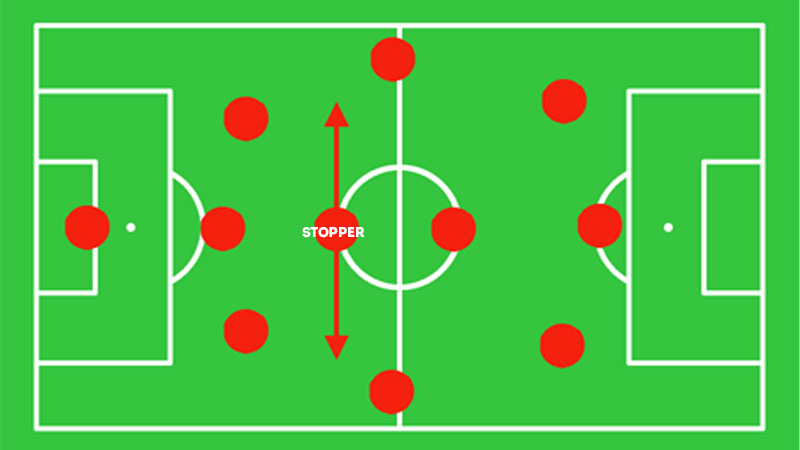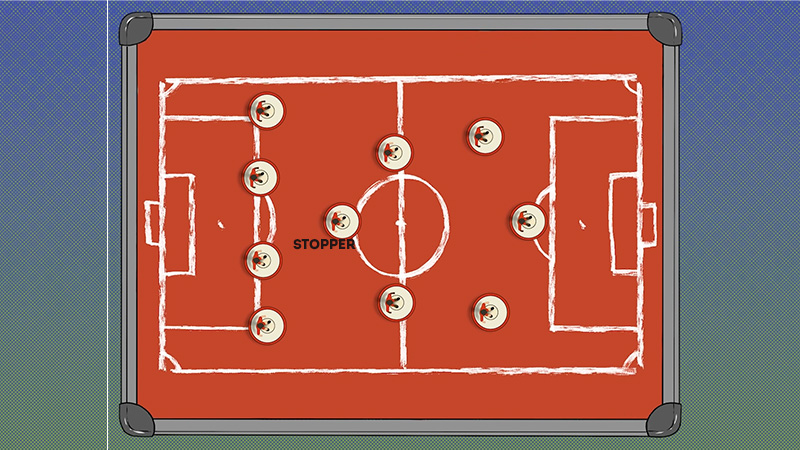The soccer stopper position, also known as the centre-back or central defender, holds a vital role in the heart of a team’s defence.
Positioned centrally within the backline, the stopper is tasked with thwarting the opposition’s attacks, providing a solid defensive foundation, and organizing the defensive structure.
With a combination of defensive prowess, aerial ability, game intelligence, and leadership qualities, the stopper is a linchpin in the team’s efforts to prevent goal-scoring opportunities.
In modern soccer, stoppers are not only expected to excel defensively but also contribute to the team’s build-up play from the back.
Their ability to read the game, make decisive tackles, and initiate attacking moves makes them indispensable assets on the field.
In this exploration, we delve into the multi-faceted role of the soccer stopper position, uncovering the skills, responsibilities, and impact of these defensive stalwarts.
What Is The Soccer Stopper Position?
The soccer stopper position, also known as the centre-back or central defender, plays a critical role in a team’s defensive setup.
The stopper is one of the last lines of defence, positioned centrally within the backline, and is responsible for thwarting opposing attackers and preventing goal-scoring opportunities.
Here are the key aspects of the soccer stopper position:
Defensive Rock
The primary role of the stopper is to provide a solid defensive foundation for the team. They are adept at reading the game, anticipating the opponent’s movements, and positioning themselves to intercept passes or make crucial tackles.
Their physical presence and ability to win aerial duels make them an imposing figure in the penalty area, deterring attackers from challenging for crosses.
Organizing the Defense
The stopper acts as a leader in the defensive line, organizing and communicating with their fellow defenders to maintain a compact and disciplined shape.
They provide instructions, ensure proper marking and direct teammates to cover gaps and potential threats.
Initiating Build-up Play
While their primary focus is on defence, stoppers are also involved in initiating the team’s build-up play from the back.
They are proficient in passing and ball distribution, looking for opportunities to launch attacks from deep positions and supporting the midfielders in setting the team’s tempo.
Sweeper Role (in some systems)
In certain tactical setups, the stopper may play the role of a sweeper, positioned slightly deeper than the rest of the defensive line.
As a sweeper, their responsibility extends to covering space behind the defence, sweeping up loose balls, and providing an additional layer of protection against through balls.
Handling Set-Pieces
Given their aerial abilities, stoppers often play a crucial role in both defensive and offensive set-pieces. Defensively, they are vital in marking and challenging opponents during corners and free-kicks.
Offensively, they may contribute by positioning themselves to attack set-piece deliveries and score goals.
The soccer stopper position is essential for defensive stability and leadership on the field.
They serve as the defensive linchpin, organizing the backline, thwarting attacks, and providing a platform for the team to build their play from the back.
Their physical attributes, defensive acumen, and ability to initiate attacks make them invaluable assets to any successful soccer team.
How Do You Play The Stopper Position In Soccer?

Source: topsoccerblog
Playing the stopper position in soccer requires a combination of defensive prowess, leadership qualities, and the ability to initiate play from the back.
Here are the key aspects of how to excel as a stopper:
Defensive Awareness and Reading the Game
As a stopper, your first priority is to excel in defence. Develop a keen sense of anticipation to read the game and predict the movements of the opposition’s attackers.
Position yourself well to cut off passing lanes and block shots, making it challenging for the opposing team to create goal-scoring opportunities.
Strong Tackling and Physical Presence
Stopper players must be adept at tackling. Work on your timing and technique to execute well-timed tackles cleanly and avoid giving away fouls.
Additionally, use your physical presence to win aerial duels and assert dominance in the penalty area during set pieces.
Organizing the Defense
As a stopper, you act as the defensive leader. Communicate effectively with your fellow defenders, providing instructions and ensuring proper marking and positioning.
By organizing the defence, you help maintain a compact and well-coordinated backline that is difficult for opponents to penetrate.
Ball Distribution and Passing Skills
Modern soccer requires stoppers to be involved in the team’s build-up play. Develop your passing skills to initiate attacks from the back.
Look for opportunities to play accurate short passes to nearby midfielders or use your vision to launch long balls to bypass the opposition’s press.
Sweeper Role (if applicable)
In certain tactical setups, you may play the sweeper role. As a sweeper, your positioning is slightly deeper than the rest of the defensive line, acting as the last line of defence.
Focus on covering space behind the defence, sweeping up loose balls, and providing an additional layer of protection against through balls.
Confidence and Composure
Playing as a stopper requires confidence and composure, especially when facing skilled attackers.
Stay calm under pressure and avoid panicking in critical situations. Trust your abilities and decision-making to make sound choices during intense moments of the game.
Set-Piece Duties
Embrace your role during set pieces. During defensive set-pieces, mark your opponents tightly, challenge for aerial balls, and clear the danger from your box.
On offensive set pieces, position yourself strategically to attack deliveries and create goal-scoring opportunities for your team.
By honing these skills and traits, you can become a commanding and influential stopper, providing a solid defensive foundation while contributing to your team’s success with your leadership and playmaking abilities.
What Skills Does A Soccer Stopper Require?

Source: expertfootball
A soccer stopper, also known as a centre-back or central defender, requires a diverse skill set to excel in their pivotal defensive role.
Here’s a description of the key skills a soccer stopper needs:
Defensive Prowess
The primary skill for a stopper is defensive excellence. This includes strong tackling, both standing and sliding, to dispossess opponents effectively and regain possession for the team.
A stopper must also be skilled at jockeying and containing attackers, using their body position to force opponents wide and away from dangerous areas.
Aerial Ability
A stopper must be dominant in the air, especially during defensive set-pieces and crosses into the box.
The ability to win headers consistently and clear the ball from dangerous situations is crucial in preventing scoring opportunities for the opposition.
Reading the Game
Exceptional game intelligence is vital for a stopper. They must have the ability to read the game, anticipate the opponent’s movements, and make quick decisions to intercept passes or cut off attacking opportunities.
Positioning and Awareness
Proper positioning is key for a stopper to maintain defensive solidity. They must be aware of the positioning of their defensive partners, maintain a compact defensive line, and cover spaces left by other defenders.
Maintaining awareness of the surrounding players and the ball is essential to anticipate potential threats and react swiftly.
Passing and Ball Distribution
Modern soccer demands that stoppers contribute to the team’s build-up play. A stopper must have good passing skills to initiate attacks from the back, find teammates with accurate short and long passes, and break lines of pressure from the opposition.
Leadership and Communication
As a defensive leader, a stopper needs strong leadership qualities. Effective communication with teammates is essential to organize the defensive line, coordinate marking assignments, and maintain defensive discipline.
Mental Resilience
Playing as a stopper can be mentally challenging, especially when facing skilful attackers or high-pressure situations.
Mental resilience is crucial to stay composed, making sound decisions under pressure, and bouncing back from mistakes.
A soccer stopper requires a combination of defensive prowess, aerial ability, game intelligence, positioning, passing skills, leadership, and mental resilience.
By honing these skills, a stopper becomes an invaluable asset to their team’s defensive stability and contributes significantly to their overall success on the soccer field.
FAQ
What is the soccer stopper position in soccer?
The soccer stopper position, also known as the centre-back or central defender, plays a crucial role in the team’s defensive structure. Positioned centrally within the backline, the stopper’s primary responsibility is to thwart the opposition’s attacks, provide a solid defensive foundation, and lead the team’s defensive efforts.
What are the key skills required to excel as a soccer stopper?
To excel as a soccer stopper, players need a diverse skill set. This includes strong defensive abilities, such as tackling and marking, as well as exceptional aerial prowess to win headers.
What role does the soccer stopper play in the team’s build-up play?
In modern soccer, stoppers are expected to contribute to the team’s build-up play from the back. They need to have good passing skills to initiate attacks from deep positions, find teammates with accurate short and long passes, and break lines of pressure from the opposition.
Can stoppers play the role of a sweeper?
Yes, in certain tactical setups, the stopper may take on the role of a sweeper. As a sweeper, the stopper plays slightly deeper than the rest of the defensive line, acting as the last line of defence.
What is the importance of mental resilience for a soccer stopper?
Mental resilience is vital for a soccer stopper, as they often face challenging situations, such as dealing with skilful attackers or high-pressure moments. Staying composed, making sound decisions under pressure, and bouncing back from mistakes are crucial aspects of a stopper’s mental resilience, allowing them to remain effective and influential throughout the game.
Conclusion
The soccer stopper position remains an indispensable and influential role in the beautiful game. As the central defender, the stopper acts as the last line of defence, utilizing a wide range of skills to protect the team’s goal and thwart the opposition’s attacking efforts.
From strong tackling and aerial prowess to game intelligence and leadership, the stopper’s skill set is crucial in maintaining defensive solidity.
Moreover, modern soccer demands stoppers to be involved in the team’s build-up play, showcasing their passing abilities and contributing to attacking movements.
As the backbone of the defensive line, stoppers embody the essence of defensive resilience and tactical acumen.
Their presence instils confidence in the team, and their ability to read the game and make crucial decisions under pressure often proves to be the difference between victory and defeat.
In this ever-evolving sport, the soccer stopper position continues to hold its significance, standing as a defensive fortress and key figure in a team’s pursuit of success.







